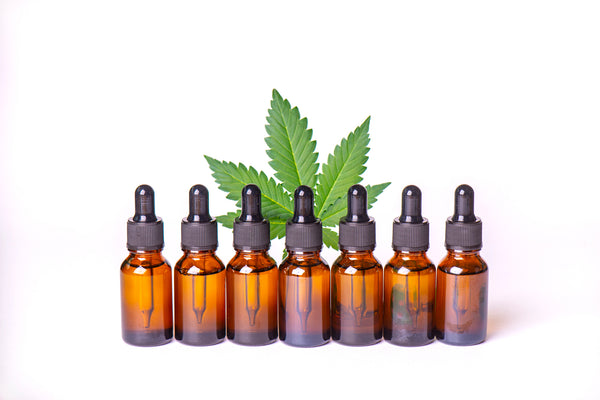Understanding the Terpene Extraction Process
Jan 31, 2022

Cannabis terpenes are finally getting the spotlight they deserve among producers, processors, consumers, and researchers. While this science on aromatherapy is not definitive, some studies show these aromatic compounds have medicinal benefits, especially when paired with other active ingredients like cannabinoids.
Cannabis research suggests an “entourage effect” occurs when consuming the full spectrum of cannabis’ chemical profile, which varies by strain and batch. Since terpenes are vulnerable compounds, terpene extraction methods must use relatively gentle processes to preserve the plant’s terpene profile.
What Are Cannabis Terpenes?
Cannabis terpenes are aromatic compounds found across the plant kingdom, particularly among conifers, herbs and spices, citrus fruits, and the cannabis plant. In the wild, terpenes serve an evolutionary purpose to deter herbivores from eating the plant and attract helpful pollinators to spread the plant’s seed.
Over 150 terpenes have been identified in the cannabis plant. Each strain contains a unique terpene profile with hundreds of different possible combinations. Terpenes are produced in the plant’s trichomes, resinous glands found primarily on the flower buds and in lower concentrations in the stems and sugar leaves.
Terpene essential oils are commonly used as flavoring agents in food and beverages or scents in cosmetics and perfumes. Many terpenes are “generally recognized as safe” (GRAS) for human consumption by the U.S. Food and Drug Administration (FDA).
While many terpenes are known to provide plants, spices, and herbs with their signature aroma, some of these terpenes may also offer medicinal benefits to the endocannabinoid system (ECS), a network of CB1 and CB2 cannabinoid receptors found throughout the body. Some terpenes directly affect how cannabinoid receptors interact with other cannabis compounds like cannabinoids.
Types of Cannabis Terpenes
Cannabis strains contain specific terpene profiles at a relatively low concentration compared to cannabinoid content. The terpene content can depend on the strain’s genetics, growing environment, drying and curing process, and processing methods.
Studies show that a combination of cannabinoids and terpenes can create potent and therapeutic effects, including relief for the following conditions:
- Inflammation
- Pain
- Anxiety
- Depression
- Epilepsy
- Cancer
Each terpene has a different effect on cannabinoids and how they interact with the ECS. For instance, some terpenes can amplify or dampen the effects of THC. Others can enhance the absorption of other terpenes and cannabinoids through the skin in topicals.
Here, we will briefly describe the most commonly found terpenes in cannabis plants and how they interact with the body, highlighting the importance of proper terpene extraction.
Myrcene
Myrcene, a monoterpene, is one of the most common terpenes found in cannabis. It has spicy, woody, and fruity notes and is commonly found in lemongrass, mangoes, and hops. Myrcene has a boiling point of 334º F.
Myrcene does not directly bind to cannabinoid receptors; instead, it helps improve cannabinoid absorption.
Common effects of myrcene include:
- Causes sedation
- Relieves depression
- Relieves pain
- Antispasmodic
- Antioxidant
- Anti-inflammatory
- Reduces cancer cell mutation
- Anti-diabetic
- Improves transdermal absorption
- Antibiotic
Beta-Caryophyllene
Beta-caryophyllene is a sesquiterpene found in black pepper, cloves, and cotton and has a peppery, woody, and spicy aroma. Beta-caryophyllene is believed to have a strong binding affinity to CB2 receptors to promote homeostasis in cells. It has a boiling point of 320º F.
Common effects of beta-caryophyllene include:
- Reduces alcohol and nicotine cravings
- Improves symptoms related to autoimmune disorders
- Gastro-protective
- Reduces kidney inflammation
- Reduces anxiety
- Causes sedation
- Relieves pain
- Antiseptic
- Antifungal
- Antibacterial
- Anti-diabetic
- Antioxidant
- Stops tumor growth
Limonene
Limonene, a monoterpene, has a citrusy scent and is found in peppermint, rosemary, and citrus fruit rinds. It does not bind with cannabinoid receptors directly but does bind to A(2A) receptors, known to play a role in increasing dopamine levels and relieving inflammation, as well as improvement in transdermal absorption. Limonene’s boiling point is 349º F.
Limonene’s effects include:
- Relieves anxiety
- Relieves depression
- Anti-inflammatory
- Stops tumor growth
- Antioxidant
- Gastro-protective
- Antifungal
- Antibacterial
- Improves transdermal absorption
- Improved GER, acid reflux, and indigestion
- Improves bowel motility
- Improves metabolism
- Dissolves gallstones
- Removes fatty acid buildup in the liver
Linalool
Linalool is a monoterpene with a subtle floral aroma and a hint of sweet citrus. It is also found in lavender, rosewood, and laurel. This terpene is believed to interact with 5-HT(3) receptors to affect nausea and vomiting. Linalool’s boiling point is 338º F.
Linalool’s effects include:
- Antipsychotic
- Relieves anxiety
- Causes sedition
- Relieves depression
- Relieves pain
- Anti-epileptic
- Anti-inflammatory
- Treats breast cancer
- Reduces nausea
- Reduces acne
Alpha-Pinene
Alpha-pinene, a monoterpene, has a pine aroma and is also found in pine needles and rosemary. While it does not bind to cannabinoids, it does mediate the effects of its compounds by promoting focus and reducing drowsiness. Alpha-pinene has a boiling point of 311º F.
Common alpha-pinene effects include:
- Promotes alertness
- Improves memory and attention
- Relieves pain
- Anti-inflammatory
- Reduces cancer cell growth
- Antioxidant
- Bronchodilator
- Antibiotic
Humulene
Humulene, a sesquiterpene, has a spicy, woody, and clove-like aroma and is found in hops, sage, and ginseng. It is believed to interact with other receptors instead of cannabinoid receptors to reduce appetite. Humulene’s boiling point is 388º F.
Humulene’s effects include:
- Relieves pain
- Anti-inflammatory
- Stops cancer cell growth
- Reduces appetite
- Improves transdermal absorption
- Antibacterial
How Can Cannabis Terpenes Be Used?

Cannabis terpenes extraction has become a value stream for processors and a health benefit for recreational and medical users. Processors can create a wide range of flavorful and aromatic cannabinoid-based products with terpenes.
Common cannabis products containing terpenes include:
- Tinctures
- Oils
- Extracts
- Vape cartridges
- Edibles
- Topicals
Some extraction methods produce products without terpenes, such as distillates or cannabinoid crystal diamonds that are nearly pure cannabinoids. As a result, these products are odorless and flavorless.
Each terpene-infused product has a different delivery method, each with its pros and cons depending on your needs. Cannabinoid and terpene products can be vaporized and inhaled, consumed sublingually, applied over the skin, or eaten.
A majority of cannabis consumers are no longer looking for the highest THC potency possible out of their products. Now, consumers are more aware of the benefits afforded by the entire range of minor cannabinoids and terpenes than consumption of isolates, for example.
Challenges Involved in Terpene Extraction
When processors extract terpenes from the plant material, they are faced with a challenge to preserve these fragile and volatile terpenes. The plant's heavier organic compounds are relatively easier to extract using specific temperatures, pressures, and organic solvents. Ultimately, processors must choose their preferred extraction process that meets their budgets, consumer demand, and desired end product.
Solvent-Based Terpene Extraction

Cannabis terpenes can be extracted from starting plant material (biomass) through many processes, including solvent extraction using solvents like light hydrocarbons (propane and butane blends), subcritical CO2 extraction, ethanol extraction, and R134a extraction.
Since terpenes are sensitive to heat and other forms of stress, solvent extraction methods must use low temperatures and pressures to preserve the extracted terpenes.
CO2 Extraction
Carbon dioxide (CO2) extraction is a popular method to separate terpenes and cannabinoids from plant material, especially since it leaves no solvent residues. Using carbon dioxide as a solvent, processors employ two separate extraction processes to remove the lighter volatile terpenes in one phase and remove the heavier cannabinoids, lipids, and other compounds in a second phase.
Usually, CO2 extraction processes start with subcritical CO2 extraction, using lower pressures and temperatures to preserve these highly volatile essential oils. After the initial phase is complete, processors can move forward with the supercritical CO2 extraction process, which uses CO2 in its supercritical state, a non-flammable and non-toxic solvent that has properties of a liquid and gas.
Ethanol Extraction
Ethanol is a solvent commonly used to extract hemp terpenes and cannabinoids, particularly cannabidiol (CBD), to produce CBD oil. However, while ethanol is an excellent solvent for high-volume hemp extraction, it can also extract unwanted impurities like chlorophyll in the solution, requiring further refinement and time.
Light Hydrocarbon Extraction
Light hydrocarbon extraction, also known as butane hash oil (BHO) extraction, is one of the most cost-effective ways to produce a wide range of cannabis end products and terpene-rich extracts.
Generally, processors determine their desired terpene profile and use a propane and butane blend, usually 70/30 in the extraction of terpenes. Butane has a boiling point of 30.2º F, while propane has a lower boiling point of -43.6º F, allowing for better extraction of the desired terpenes.
BHO extraction boasts a high-yield and fast and high throughput for processors who need to meet market demand. These non-polar solvents can remove the lighter oils and volatile compounds without extracting too many residual solvents and other components like chlorophyll, fats, waxes, and lipids.
R134a Extraction
R134a extraction uses tetrafluoroethane (TFE), also known as R134a, under low pressures and room temperatures to extract cannabinoids and terpenes without undesirable compounds like chlorophyll, fats, lipids, and waxes. Because the process occurs at room temperatures, there is no strong heat used, and many terpenes can be preserved.
Solventless Terpene Extraction
Solventless terpene extractions use agitation, heat, and pressure to extract terpenes without the need for potentially flammable and dangerous extraction solvents. Here are the most common solventless terpene extraction methods.
Steam Distillation
Steam distillation is commonly used to extract essential oils from botanicals. The cannabis plant material is exposed to steam from boiling water during the process. As steam passes through the biomass, the steam captures the plant's essential oil and carries them to a cooled condenser that cools and liquefies the solution.
Most lighter oils float above the water content to be separated later, and a lower concentration of oxygenated terpenes is left in the water. This solution is known as a hydrosol mixture.
Research indicates that steam distillation takes out more hydrocarbon terpenes like beta-caryophyllene and myrcene. Unlike other methods that require fresh-frozen or dried and cured material, steam distillation can be performed on fresh cannabis plants. This can allow producers to perform extractions at the cultivation facility, reducing the need for distribution to processing facilities.
Some steam distillation processes can occur under a deep vacuum to significantly reduce the temperatures needed to distill the terpenes.
Hydro Distillation
Hydro distillation has many similarities to steam distillation, but the main difference is that the cannabis biomass is exposed directly to boiling water. Water boils at 212º F, often too hot for the extraction of terpenes. Many cannabis compounds are degraded at this temperature, directly affecting the product's aroma and therapeutic benefits.
Mechanical Extraction
Mechanical terpene extraction methods use agitation, pressure, and heat to break off or compress the trichome resin from the cannabis plant material, including flower, kief, and bubble hash.
Rosin pressing at certain temperatures can extract a high amount of the material's terpenes. However, it is impossible to completely isolate these lighter compounds from their heavier counterparts like cannabinoids.
How Fresh-Frozen Cannabis Plant Material Preserves Terpenes

Traditionally, cannabis plants are dried and cured to refine their terpene and cannabinoid profile, reduce excess moisture, and remove chlorophyll that can make the flower and extract taste harsh.
As an alternative to dried and cured cannabis that can lose out on evaporated terpenes during the process, processors use fresh-frozen plant material to preserve the peak cannabinoid and terpene profile.
An extraction process that uses fresh-frozen material is essential to getting the most trichomes and terpenes from the plant. Common cannabis products made with fresh-frozen cannabis flowers include live resin, terp sauce, and other high-terpene, full-spectrum extracts (HTFSE).
The Importance of Terpenes for Medical and Recreational Users
Producers and processors now understand the incredible value cannabis terpenes can bring to not only their bottom line but customers’ well-being. For medical cannabis patients, terpenes provide an additional and potentially therapeutic compound that can help with many symptoms and conditions. Terpenes provide a pleasant and wide-ranging combination of scent profiles for recreational users.
How Media Bros Can Improve Terpene Extraction
Media Bros can help extraction companies preserve the volatile oils found in cannabis strains with cutting-edge color remediation filter media. Media Bros’ line of filter media can improve the color and clarity of different qualities of biomass and cannabis oil while preserving the original terpene profiles of the crude extract.






